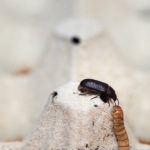A look at the insect world through the eyes of Wadudu
We hear more and more about it, eating insects, alternative protein, shortage of agricultural land, growing world population. But what are we already doing, and what is about to happen? In this article you can read about how Wadudu experiences the sector in Europe, what is about to happen and how Wadudu fits into that picture.
‘Abundance of information’
When you type something about a shortage of agricultural land on your favorite search engine, news articles all come with one and the same conclusion. In 2050 we have a challenge; The current way of consuming, producing and processing is not sufficient for the population of that time. So an alternative must be looked at. Anyone who has studied the world of insects has probably also read the following several times; Eating insects is already done by more than 2 billion people. It is a daily routine in (parts of) Asia, South America and Africa. We “Westerners” apparently still have to get used to this.
‘We don’t put our teeth in a cow either’
When talking about eating insects, there is often a negative reaction. We think this is (partly) understandable, we are used to going to the supermarket and then walking out satisfied with a bowl of sliced meat. Insects offer a lot of potential, but in the way we are used to; processed, almost unrecognizable and preferably already flavored. Think of the beautiful insect burger from Bugfoundation, the basil paste from Snack-Insects or the snacks from Little Hero. This type of product is most likely to be successful in the coming years.
The other side of the insect sector focuses on feed. Currently, the entire sector is still being held back by legislation and regulations. Processed insects are not yet allowed in poultry, pig or cow feed. Fish are already allowed to eat processed insects. We see companies such as Agriprotein (UK) and Protix (NL) responding strongly to this. InnovaFeed (FR) has also joined these major players in the market since June 2019. It is expected that in 2020 poultry will also be able to enjoy processed insects. Feeding live insects to poultry has been researched and proven successful, enriching the life of laying hens. The downside of live insects in a chicken shed? The insects will crawl away if not eaten. This means that they can pupate and reproduce, something the poultry farmer is not waiting for. A solution that is currently being applied is the conscious breeding of insects at the location of the poultry farmer. This does not hold up on a larger scale.
It is precisely within this poultry sector that a great leap can be made in sustainability, replacing soy and / or fish meal, but also improving the quality of life of the chickens. Research shows that chickens like to return to their primal behavior; pecking insects from the ground. This results in more active hens and less pecking from each other on the feather deck of the neighbor. More research and professionalization will be needed in the coming years to achieve a mature sector. Wadudu tries to contribute to this in various ways. For example, various studies are constantly being conducted in collaboration with colleges and universities.
“Open innovation is the key to success”
The insect center is built on three pillars; research, production and advice. Thanks to a transparent attitude and the sharing of knowledge, Wadudu has grown into more than a company. We collaborate with growers, investors, colleges & universities, enthusiastic entrepreneurs and government agencies. In this way, Wadudu contributes to a better future together with its partners.
“Craftsmanship is the basis”
Wadudu is now focusing on the propagation of flour beetles (Tenebrio Molitor). In this way we offer others the opportunity to start breeding insects relatively easily. The focal point for the new breeder is the range from small larva to adult larva. Wadudu takes on the daunting task of propagation, egg harvesting and hatching. That possibility would never have existed if Wadudu had ignored the research side of insects.
The company is committed to guiding other growers and to provide advice in the field of financing, sales, site conversion and the supply of starting material. The starting grower is thus unburdened and starts with a good basis.

At the moment (summer 2019) there are approximately 40 breeders of insects in the Netherlands. Current estimates are that these growers will develop, automate and grow further. Figure 1.1 shows a forecast of growth within the insect sector in Europe.
The sector is at the level where poultry was in the 1960s. The objective is to continue to develop and to continue to innovate. The catch-up effort that insect breeders are deploying throughout Europe is gigantic, but it takes time. The expected turnover worldwide will grow strongly according to an American study. The results are shown in Figure 1.2.

Wadudu supports developments in the sector, welcomes innovation and will grow itself. The goal is to start a production location in 2019 where 10 times the production will be compared to the current research location in Beilen. With this location, the company wants to enable others to be able to / continue to grow, to share information and to ensure that the sector matures. This chain development is central.


